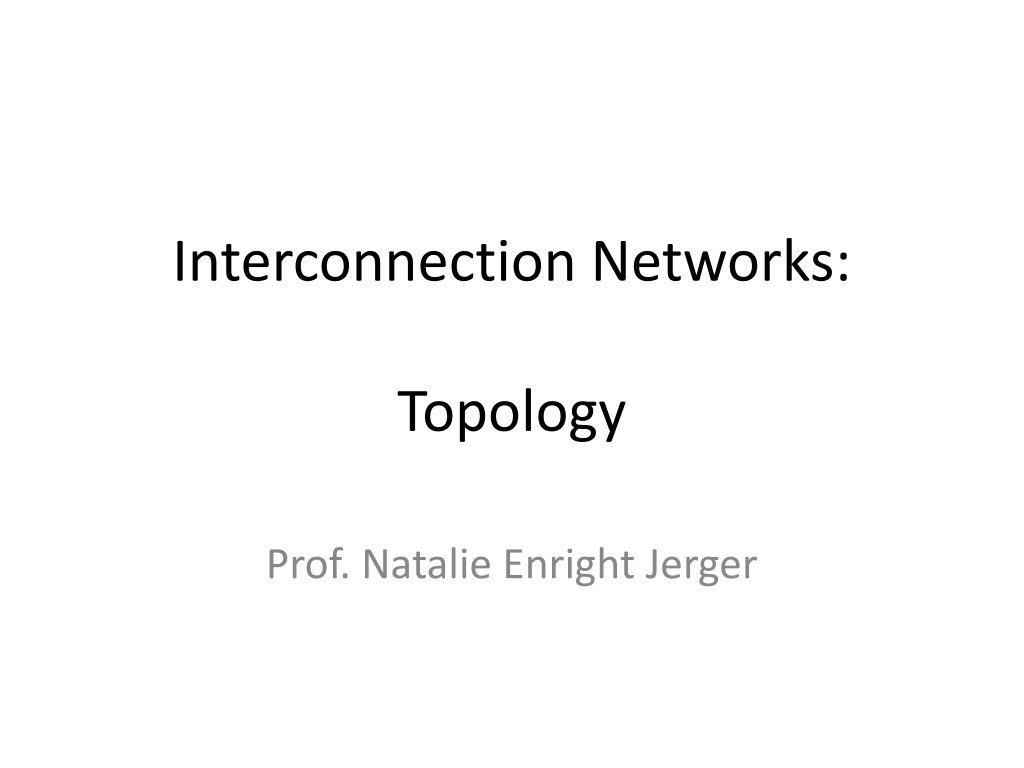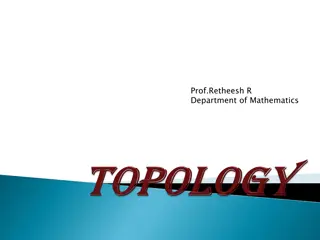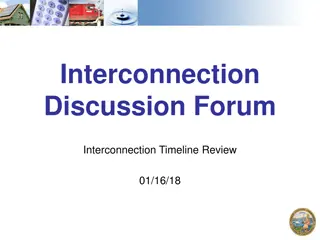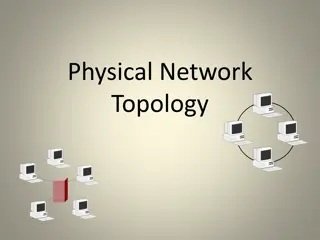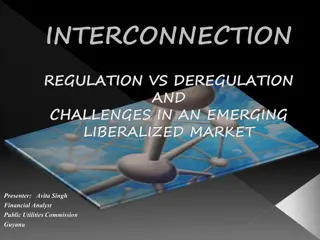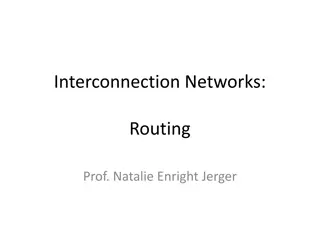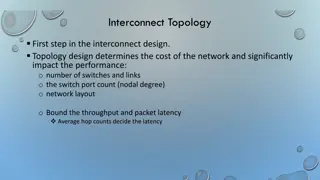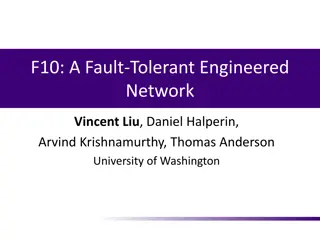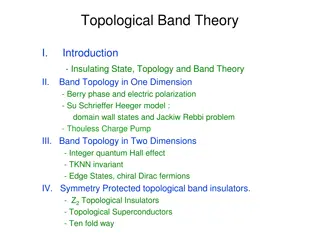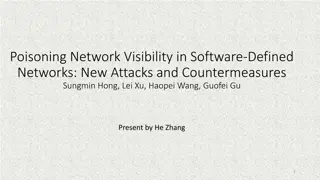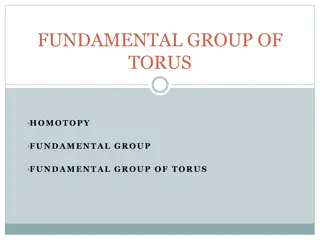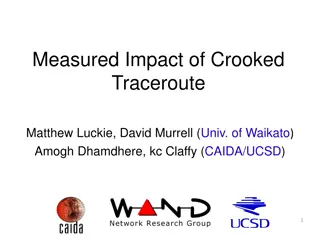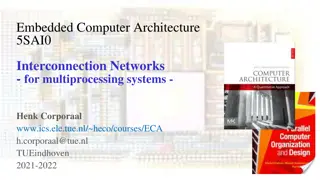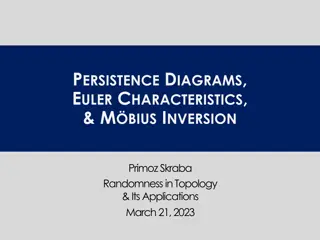Understanding Interconnection Networks Topology
Exploring the topology of interconnection networks helps determine the arrangement of channels and nodes, impacting network cost, performance, latency, energy consumption, and complexity of implementation. Abstract metrics such as degree, hop count, and network diameter play crucial roles in evaluating the network's performance and cost. Higher degrees at nodes increase costs, while hop count reflects network latency. Considerations of routing, flow control, and ideal scenarios further shape the network design process.
Download Presentation

Please find below an Image/Link to download the presentation.
The content on the website is provided AS IS for your information and personal use only. It may not be sold, licensed, or shared on other websites without obtaining consent from the author. Download presentation by click this link. If you encounter any issues during the download, it is possible that the publisher has removed the file from their server.
E N D
Presentation Transcript
Interconnection Networks: Topology Prof. Natalie Enright Jerger
Topology Overview Definition: determines arrangement of channels and nodes in network Analogous to road map Often first step in network design Significant impact on network cost-performance Determines number of hops Latency Network energy consumption Implementation complexity Node degree Ease of layout Fall 2014 ECE 1749H: Interconnection Networks (Enright Jerger) 2
ABSTRACT METRICS Fall 2014 ECE 1749H: Interconnection Networks (Enright Jerger) 3
Abstract Metrics Use metrics to evaluate performance and cost of topology Also influenced by routing/flow control At this stage Assume ideal routing (perfect load balancing) Assume ideal flow control (no idle cycles on any channel) Fall 2014 ECE 1749H: Interconnection Networks (Enright Jerger) 4
Abstract Metrics: Degree Switch Degree: number of links at a node Proxy for estimating cost Higher degree requires more links and port counts at each router B B B A 2,3,4 4 2 A A Fall 2014 ECE 1749H: Interconnection Networks (Enright Jerger) 5
Abstract Metrics: Hop Count Path: ordered set of channels between source and destination Hop Count: number of hops a message takes from source to destination Simple, useful proxy for network latency Every node, link incurs some propagation delay even when no contention Minimal hop count: smallest hop count connecting two nodes Fall 2014 ECE 1749H: Interconnection Networks (Enright Jerger) 6
Hop Count Network diameter: large min hop count in network Average minimum hop count: average across all src/dst pairs Implementation may incorporate non-minimal paths Increases average hop count Fall 2014 ECE 1749H: Interconnection Networks (Enright Jerger) 7
Hop Count B B B A A A Max = 4 Avg = 2.2 Max = 4 1.77 Max = 2 1.33 Uniform random traffic Ring > Mesh > Torus Derivations later Fall 2014 ECE 1749H: Interconnection Networks (Enright Jerger) 8
Latency Time for packet to traverse network Start: head arrives at input port End: tail departs output port Latency = Head latency + serialization latency Serialization latency: time for packet with Length L to cross channel with bandwidth b (L/b) Approximate with hop count Other design choices (routing, flow control) impact latency Unknown at this stage Fall 2014 ECE 1749H: Interconnection Networks (Enright Jerger) 9
Abstract Metrics: Maximum Channel Load Estimate max bandwidth the network can support Max bits per second (bps) that can be injected by every node before it saturates Saturation: network cannot accept any more traffic Determine most congested link For given traffic pattern Will limit overall network bandwidth Estimate load on this channel Fall 2014 ECE 1749H: Interconnection Networks (Enright Jerger) 10
Maximum Channel Load Preliminary Don t know specifics of link yet Define relative to injection load Channel load of 2 Channel is loaded with twice injection bandwidth If each node injects a flit every cycle 2 flits will want to traverse bottleneck channel every cycle If bottleneck channel can only handle 1 flit per cycle Max network bandwidth is link bandwidth A flit can be injected every other cycle Fall 2014 ECE 1749H: Interconnection Networks (Enright Jerger) 11
Maximum Channel Load Example A B E F C D G H Uniform random Every node has equal probability of sending to every node Identify bottleneck channel Half of traffic from every node will cross bottleneck channel 8 x = 4 Network saturates at injection bandwidth Fall 2014 ECE 1749H: Interconnection Networks (Enright Jerger) 12
Bisection Bandwidth Common off-chip metric Proxy for cost Amount of global wiring that will be necessary Less useful for on-chip Global on-chip wiring considered abundant Cuts: partition all the nodes into two disjoint sets Bandwidth of a cut Bisection A cut which divides all nodes into (nearly) half Channel bisection min. channel count over all bisections Bisection bandwidth min. bandwidth over all bisections With uniform traffic of traffic crosses bisection Fall 2014 ECE 1749H: Interconnection Networks (Enright Jerger) 13
Throughput Example 0 1 2 3 4 5 6 7 Bisection = 4 (2 in each direction) With uniform random traffic 3 sends 1/8 of its traffic to 4,5,6 3 sends 1/16 of its traffic to 7 (2 possible shortest paths) 2 sends 1/8 of its traffic to 4,5 Etc Channel load = 1 Fall 2014 ECE 1749H: Interconnection Networks (Enright Jerger) 14
Path Diversity Multiple shortest paths between source/destination pair (R) Fault tolerance Better load balancing in network Routing algorithm should be able to exploit path diversity B B B RA-B = 6 RA-B = 2 A RA-B = 1 A A Fall 2014 ECE 1749H: Interconnection Networks (Enright Jerger) 15
NETWORK EVALUATION Fall 2014 ECE 1749H: Interconnection Networks (Enright Jerger) 16
Evaluating Networks Analytical and theoretical analysis E.g. mathematical derivations of max channel load Analytical models for power (DSENT) Simulation-based analysis Network-only simulation with synthetic traffic patterns Full system simulation with real application benchmarks Hardware implementation HDL implementation to measure power, area, frequency etc. Measurement on real hardware Profiling and analyzing communication Fall 2014 ECE 1749H: Interconnection Networks (Enright Jerger) 17
Evaluating Topologies Important to consider traffic pattern Talked about system architecture impact on traffic If actual traffic pattern unknown Synthetic traffic patterns Evaluate common scenarios Stress test network Derive various properties of network Fall 2014 ECE 1749H: Interconnection Networks (Enright Jerger) 18
Traffic Patterns Historically derived from particular applications of interest Spatial distribution Matrix Transpose Transpose traffic pattern di = si+b/2 mod b b-bit address, di: ith bit of destination Fall 2014 19
Traffic Patterns Examples Fast Fourier Transform (FFT) or sorting application shuffle permutation Fluid dynamics neighbor patterns Shuffle: di = si-1 mod b Fall 2014 Neighbor: dx = sx+ 1 mod k ECE 1749H: Interconnection Networks (Enright Jerger) 20
Traffic Patterns (3) Uniform random Each source equally likely to communication with each destination Most commonly used traffic pattern Very benign Traffic is uniformly distributed Balances load even if topology/routing algorithm has very poor load balancing Need to be careful But can be good for debugging/verifying implementation Well-understood pattern Fall 2014 ECE 1749H: Interconnection Networks (Enright Jerger) 21
Stress-testing Network Uniform random can make bad topologies look good Permutation traffic will stress-test the network Many types of permutation (ex: shuffle, transpose, neighbor) Each source sends all traffic to single destination Concentration of load on individual pairs Stresses load balancing Fall 2014 ECE 1749H: Interconnection Networks (Enright Jerger) 22
Traffic Patterns For topology/routing discussion Focus on spatial distribution Traffic patterns also have temporal aspects Bursty behavior Important to capture temporal behavior as well Motivate need for new traffic patterns Fall 2014 ECE 1749H: Interconnection Networks (Enright Jerger) 23
Full System Simulation NoC Simulator Full System Simulator Packets Sent Processor Application Cache NoC Disk Other Components Feedback! Packets Arrived Accurate But Slow Fall 2014 ECE 1749H: Interconnection Networks (Enright Jerger) 24
Trace Simulation NoC Simulator Trace Simulator Trace Packets Sent Processor NoC B Cache Application NoC A Disk Other Faster But Less Accurate Fall 2014 ECE 1749H: Interconnection Networks (Enright Jerger) 25
Traffic Patterns NoC Simulator Synthetic Traffic Driver Traffic Pattern Uniform Random Bit Complement Application Bit Reverse Bit Rotation NoC Shuffle Transpose Tornado Neighbour Very Fast But Inaccurate Fall 2014 ECE 1749H: Interconnection Networks (Enright Jerger) 26
COMMON TOPOLOGIES Fall 2014 ECE 1749H: Interconnection Networks (Enright Jerger) 27
Types of Topologies Focus on switched topologies Alternatives: bus and crossbar Bus Connects a set of components to a single shared channel Effective broadcast medium Crossbar Directly connects n inputs to m outputs without intermediate stages Fully connected, single hop network Component of routers Fall 2014 ECE 1749H: Interconnection Networks (Enright Jerger) 28
Types of Topologies Direct Each router is associated with a terminal node All routers are sources and destinations of traffic Indirect Routers are distinct from terminal nodes Terminal nodes can source/sink traffic Intermediate nodes switch traffic between terminal nodes To date: Most on-chip networks use direct topologies Fall 2014 ECE 1749H: Interconnection Networks (Enright Jerger) 29
Torus (1) K-ary n-cube: kn network nodes N-Dimensional grid with k nodes in each dimension 2,3,4-ary 3-mesh 3-ary 2-cube 3-ary 2-mesh Fall 2014 ECE 1749H: Interconnection Networks (Enright Jerger) 30
Torus (2) Map well to planar substrate for on-chip Topologies in Torus Family Ex: Ring -- k-ary 1-cube Edge Symmetric Good for load balancing Removing wrap-around links for mesh loses edge symmetry More traffic concentrated on center channels Good path diversity Exploit locality for near-neighbor traffic Fall 2014 ECE 1749H: Interconnection Networks (Enright Jerger) 31
Hop Count Average shortest distance over all pairs of nodes Torus: nk 4 k even Hmin= 4-1 nk k odd 4k For uniform random traffic Packet travels k/4 hops in each of n dimensions nk 3 k even Mesh: Hmin= 3-1 nk k odd 3k Fall 2014 ECE 1749H: Interconnection Networks (Enright Jerger) 32
Torus (4) Degree = 2n, 2 channels per dimension All nodes have same degree Total channels = 2nN Fall 2014 ECE 1749H: Interconnection Networks (Enright Jerger) 33
Channel Load for Torus Even number of k-ary (n-1)-cubes in outer dimension Dividing these k-ary (n-1)-cubes gives a 2 sets of kn-1 bidirectional channels or 4kn-1 Traffic from each node cross bisection channelload =N 4N=k k 2 8 Mesh has the bisection bandwidth of torus Fall 2014 ECE 1749H: Interconnection Networks (Enright Jerger) 34
Deriving Channel Load: 4-ary 2-cube Divide network in half Number of bisection channels 8 links, bidirectional = 16 channels 4N k =4 16 4 traffic crosses bisection N 2=8 N/2 traffic distributed over 16 links Channel load = Loaded at twice injection bandwidth Fall 2014 ECE 1749H: Interconnection Networks (Enright Jerger) 35
Torus Path Diversity 2 dimensions* NW, NE, SW, SE combos 2 edge and node disjoint minimum paths *assume single direction for x and y Fall 2014 ECE 1749H: Interconnection Networks (Enright Jerger) 36
Mesh A torus with end-around connection removed Same node degree Bisection channels halved Max channel load = k/4 Higher demand for central channels Load imbalance Fall 2014 ECE 1749H: Interconnection Networks (Enright Jerger) 37
Butterfly Indirect network 0 1 0 0 0 00 10 20 K-ary n-fly: kn network nodes 1 1 2 2 01 11 21 3 3 4 4 Routing from 000 to 010 Dest address used to directly route packet Bit n used to select output port at stage n 02 12 22 5 5 6 6 03 13 23 7 7 2-ary 3-fly 2 input switch, 3 stages Fall 2014 ECE 1749H: Interconnection Networks (Enright Jerger) 38
Butterfly (2) Rxy=1 No path diversity Can add extra stages for diversity Increase network diameter 0 0 x0 10 20 00 1 1 2 2 x1 11 21 01 3 3 4 4 x2 12 22 02 5 5 6 6 x3 13 23 03 7 7 Fall 2014 ECE 1749H: Interconnection Networks (Enright Jerger) 39
Butterfly (3) Hop Count LogkN + 1 Does not exploit locality Hop count same regardless of location Switch Degree = 2k Requires long wires to implement Fall 2014 ECE 1749H: Interconnection Networks (Enright Jerger) 40
Butterfly: Channel Load Hmin x N: Channel demand Number of channel traversals required to deliver one round of packets Channel Load uniform traffic Equally loads channels =kn(n+1) kn(n+1)=1 NHmin C Increases for adversarial traffic Fall 2014 ECE 1749H: Interconnection Networks (Enright Jerger) 41
Butterfly: Deriving Channel Load Divide network in half Number of bisection channels: 4 0 0 00 10 20 1 1 2 2 01 11 21 4 nodes (top half) send traffic to lower half 4 2= 2 3 3 4 4 02 12 22 5 5 6 6 03 13 23 Distributed across 2 channels (C) Channel load = 1 7 7 Fall 2014 ECE 1749H: Interconnection Networks (Enright Jerger) 42
Butterfly: Channel Load Adversarial traffic All traffic from top half sent to bottom half 0 0 00 10 20 1 1 2 2 01 11 21 3 3 4 4 E.g. 0 sends to 4, 1 sends to 5 Channel load: 2 Loaded at injection bandwidth 02 12 22 5 5 6 6 03 13 23 7 7 Fall 2014 ECE 1749H: Interconnection Networks (Enright Jerger) 43
Clos Network 3-stage indirect network Larger number of stages: built recursively by replacing middle stage with 3-stage Clos Characterized by triple (m, n, r) M: # of middle stage switches N: # of input/output ports on input/output switches R: # of input/output switches Hop Count = 4 Fall 2014 ECE 1749H: Interconnection Networks (Enright Jerger) 44
Clos Network rxr input switch nxm input switch mxn output switch rxr input switch nxm input switch mxn output switch rxr input switch nxm input switch mxn output switch rxr input switch nxm input switch mxn output switch rxr input switch Fall 2014 ECE 1749H: Interconnection Networks (Enright Jerger) 45
Clos Network Strictly non-blocking when m > 2n-1 Any input can connect to any unique output port r x n nodes Degree First and last stages: n + m, middle stage: 2r Path diversity: m Can be folded along middle switches Input and output switches are shared Fall 2014 ECE 1749H: Interconnection Networks (Enright Jerger) 46
Folded Clos (Fat Tree) Bandwidth remains constant at each level Regular Tree: Bandwidth decreases closer to root Fall 2014 ECE 1749H: Interconnection Networks (Enright Jerger) 47
Fat Tree (2) Provides path diversity Fall 2014 ECE 1749H: Interconnection Networks (Enright Jerger) 48
Application of Topologies to On-Chip Networks FBFly Convert butterfly to direct network Swizzle switch Circuit-optimized crossbar Rings Simple, low hardware cost Mesh networks Several products/prototypes MECS and bus-based networks Broadcast and multicast capabilities Fall 2014 ECE 1749H: Interconnection Networks (Enright Jerger) 49
Implementation Folding Equalize path lengths Reduces max link length Increases length of other links 0 1 2 3 3 2 1 0 Fall 2014 ECE 1749H: Interconnection Networks (Enright Jerger) 50
